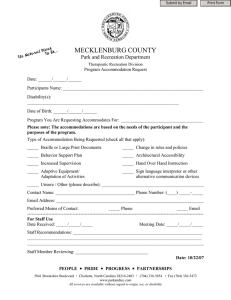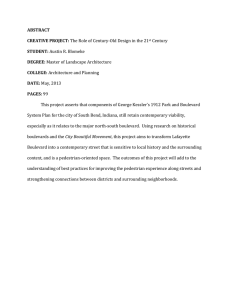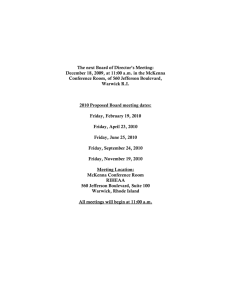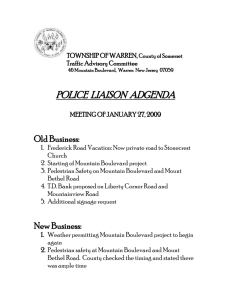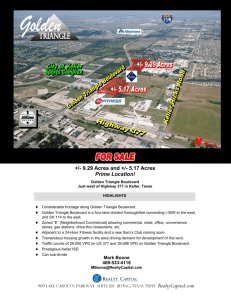Public Open House BROOKSHIRE BOULEVARD ROADWAY CLASSIFICATION STUDY
advertisement
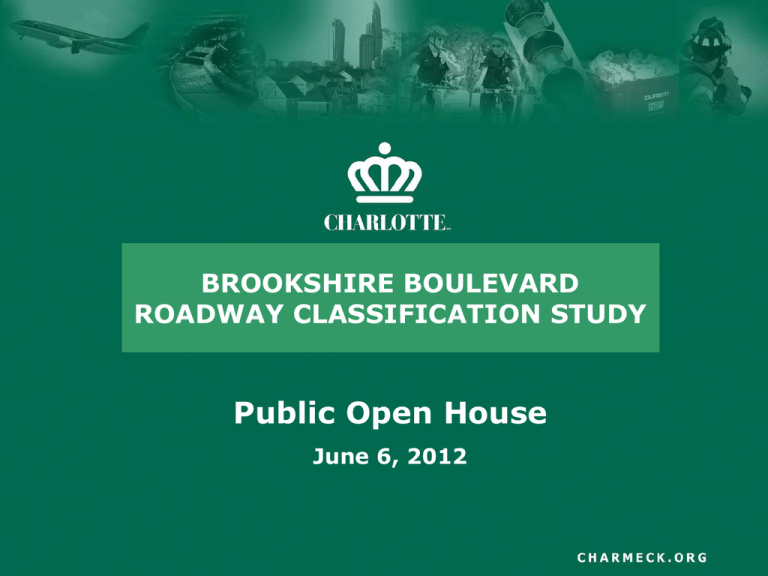
BROOKSHIRE BOULEVARD ROADWAY CLASSIFICATION STUDY Public Open House June 6, 2012 Today’s Expected Outcomes • No recommendations presented today • Summary of findings • Gather feedback • Begin to define vision for corridor/segments Presentation Outline • What is a Roadway Classification Study and what does it affect? • Findings about Brookshire Boulevard • Tradeoffs between different classifications • Discuss vision for corridor/segments What does “Roadway Classification” affect? • Motorists – speed limit, lane widths, median widths, shoulder, curb & gutter, street lighting, and driveway & street connections • Pedestrians – sidewalk location and width, intersection crosswalks, pedestrian signals, median refuge, bus stops, and mid-block pedestrian crossings • Bicyclists – bike lane location and width, multi-use paths, connectivity to greenways & trails, and overall bicycle accommodations • Development – land use, setbacks, access, and connectivity Goals of Study • Develop a vision for the future of Brookshire Boulevard • Develop an overall plan for “functional” or “roadway type” classification • Determine appropriate classification and cross section by segments and transition areas • Establish consistency and compatibility in land development and transportation investment decisions • Over time, use the results of this Study to affect access, development, and mobility for existing and new businesses and residents along these roadways. Brookshire Boulevard Primary Focus of the Brookshire Boulevard Roadway Classification Study Comprehensive ThoroughfareCTP Transportation (Expressway Plan or Boulevard) Plan (CTP) Urban Street USDG/NCDOT NCDOT Design Complete Streets Complete Guidelines (Parkway or Boulevard) Streets (USDG) A Roadway Classification Study is NOT… • A preliminary or final design project • A construction project • A maintenance project • A widening or alignment study • A right-of-way acquisition project • An environmental assessment • A land use plan • A funding prioritization plan • However over time, the Study outcomes will affect decisions that pertain to each of these actions! Brookshire Boulevard Regional Context • Radial thoroughfare connecting adjacent counties with Charlotte’s Center City • Fully-controlled access from I-277/John Belk Freeway to I-85 and from MecklenburgGaston County line to nearly NewtonConover • Crosses and connects two interstates (I-85, I-485) • Primary trucking route • High-demand, intercounty & intra-county commuter route • No bus stops • No bike/ped facilities NC 16 Controlled Access from Bellhaven Blvd. to Catawba County (23 miles) NC 16 Controlled Access from East 3rd Street to I-85 (5 miles) Study Limits Brookshire Boulevard Inventory of existing characteristics – Posted speed limit – Number of lanes – Number and spacing of street intersections (interchanges, signals, stop sign, right-in/right-out) – Driveway access – Presence of medians – Pedestrian and bicycle accommodations – Adjacent land uses and community context – Bus stops and transit access – Street lighting Brookshire Boulevard Definition of corridor segments – Homogeneous roadway characteristics and land use context BR3 BR2 – Transition points – Public input ID BR1 From To Mileage BR1 I-85 Bellhaven Boulevard 3.4 BR2 Bellhaven Boulevard I-485 2.2 BR3 I-485 Gaston County Line 2.7 Brookshire Boulevard Tradeoffs Between Classifications Roadway Classification Characteristic USDG Boulevard CTP Boulevard USDG Parkway CTP Expressway Speed Limit 45 mph 55 mph Access ¼ mile spacing (Managed) ½ mile spacing (Controlled; additional surrounding street connectivity or extension of existing streets) Driveways Expected and appropriate Inappropriate (alternate access required) Intersections Signals Stop signs with full movements Directional lefts (right-in/right-out) Grade separation Signals Right-in/right-out or eliminated Medians 20’ or less 20’ or more Pedestrians Sidewalks (10’ or less from travel lanes; crosswalks at signals) Separate, parallel facility (multi-use path beyond r/w; grade separated or no crosswalk) Transit Access Bus stops on roadway Separate facility (Park-n-Ride, parallel street) Bicyclists Bike lanes Separate, parallel facility (multi-use path beyond r/w or nearby parallel street) Brookshire Boulevard Brookshire Boulevard Brookshire Boulevard Brookshire Boulevard BR3 BR2 BR1 Brookshire Boulevard Developing the Vision for the Corridor/Segments • Access – Segments where access would remain unchanged – Segments where access would become more managed • Fewer driveways • Fewer full-movement cross streets • Minor changes to surrounding transportation network – Segments where access would become controlled • No driveways • Grade separations or interchanges • Fewer or no traffic signals • No stop-controlled, full-movement intersections • Additional transportation network connectivity (new streets, extension of existing streets) • Concentrating cross traffic or side street traffic at fewer intersections resulting in wider or grade separated intersections, wider pedestrian crosswalks • Multi-modal – Addition of bike lanes, sidewalks – Addition of separate, parallel facility for bicyclists and pedestrians Brookshire Boulevard Boulevard Brookshire Boulevard Parkway Brookshire Boulevard Boulevard Potential Full Median Opening & Access with Left Turn Lanes Brookshire Blvd. Brookshire Boulevard Parkway Potential Indirect Access to Brookshire Blvd. Brookshire Blvd. Brookshire Boulevard Boulevard Brookshire Boulevard Parkway Next Steps • Define framework of the study – Steering Committee presentation and corridor Tour • Choices, tradeoffs, steering committee visioning • Public outreach • Findings and analyses • Public Open House to present findings and visioning for corridor/segments • Refine vision, adjust findings & recommendations (June 2012) • Public Open House to present recommendations (July 2012) • Finalize Study (July/August 2012) Additional Info • Brian D. Horton, AICP CDOT Project Manager 704-432-5237 bhorton@charlottenc.gov • Visit http://cdotprojects.charlottenc.gov and click on “Brookshire Blvd. and W.T. Harris Boulevard Study” to find out more.
